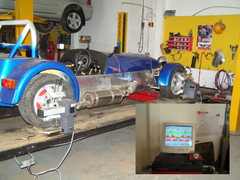Nick Davison
|
| posted on 29/3/05 at 04:04 PM |

|
|
Camber angle
Excuse the ignorance but can anyone tell me if the camber angle should be negative or positive, ie. top of the wheel toward the body for positive and
away from it for negative? Also is 1.5deg good for road use?
I have set up 1.5deg last weekend but I'm not going to say which way for fear of looking a pratt!
Nick
|
|
|
|
|
Neville Jones
|
| posted on 29/3/05 at 04:31 PM |

|
|
Camber
I think the convention is:
Negative -- Top of wheel towards car
Positive -- Top of wheel away from car
More than 1degree may be excess for a road car, as it will tend to steer with bumps and odd camber changes.
Nev.
|
|
|
Jon Ison
|
| posted on 29/3/05 at 04:36 PM |

|
|
IMHO somewhere around 1 / 1.5 negative is fine for the road.
|
|
|
britishtrident
|
| posted on 29/3/05 at 05:20 PM |

|
|
Camber depends a lot on the type of miles you do ---- a lot of camber will kill the tyres if you do a lot of straight line/motorway mileage --- OK
not really what you built the thing for :-)
But if you do a lot of twisty roads and hard cornering and 1.5 negative will give more even wear across the width of the tyre.
Range of cambers used by Locosters seem to be -0.5 to -1.5.
|
|
|
Nick Davison
|
| posted on 29/3/05 at 06:41 PM |

|
|
Thanks for that chaps, and yes it is going to be going round the corners in prefference to motorways.
As far as which way I have adjusted it already, I don't feel a pratt, it was the right way ( smugg self satisfied grin ).
Nick
|
|
|
Volvorsport
|
| posted on 29/3/05 at 07:42 PM |

|
|
hey nick where abouts in lincoln are you ?
id like to see some more installation pics of turbo etc
www.dbsmotorsport.co.uk
getting dirty under a bus
|
|
|
Nick Davison
|
| posted on 30/3/05 at 08:00 AM |

|
|
V-S
I am actually in a village just south of Sleaford but no one knows where that is so I have listed my location as Lincoln. Are you in Lincoln your
self?
The turbo installation is, as far as turbos go, not too special it is a stock Lancia Thema 2.0L turbo tied onto a Fiat 131 box with modified bell
housing. The power and torque is close to that pushed out by a 2.8i Capris so I have included a 2.8i Capris axle so with the reduced weight of the
car and the engine it should do quite well.
There are plenty of photos on my archive although they don't do justice to the volume of work which has gone into the engine installation. As a
guide there is about 5 to 10mm clearance between engine components, pipes etc and chassis so loads of P clips and compilcated routes for all the air
tappings etc. And as for the wiring, that is a novel in it's self!
Nick

[Edited on 30/3/05 by Nick Davison]
|
|
|
albertz
|
| posted on 30/3/05 at 08:13 PM |

|
|
Once again, excuse the ignorance, but......how do you go about measuring the camber to that accuracy? I assume there are specialised tools involved?
Or is there a simple DIY way of doing it accurately. At the moment mine is done by eye 
|
|
|
Mark Allanson
|
| posted on 30/3/05 at 08:44 PM |

|
|
Hunter Systems are cheap at around £18,500!!
 
Rescued attachment Hunter.jpg
If you can keep you head, whilst all others around you are losing theirs, you are not fully aware of the situation
|
|
|
Liam
|
| posted on 30/3/05 at 08:58 PM |

|
|
Get on a flat base (garage floor).
Take wheel off.
Bolt on large piece of thick ply instead.
Use your roofer's square and some trigonometry.
Liam
|
|
|
Nick Davison
|
| posted on 1/4/05 at 08:27 AM |

|
|
Mark
I take it you can buy that set up for £10 + P&P from ScrewFix?
Nick
Albertz
I used the wood bolted to the wheel. Using trig and a decent sirit level to give the perpendicular, the piece of wood should lean inwards toward the
car by 13mm over a 500mm measured distance. If you have doubts as to the accuracy using 500mm then increase the 500mm substantially and apply the
equation, this will give a larger distance to measure at the top of the stick and therefore less margin for error.
If X is the distance you are trying to find then the equation is
X = (length of measurement up the stick in mm)xtan(angle required)
So I used
X = 500xtan1.5
X = 13.1mm
Nick
|
|
|













